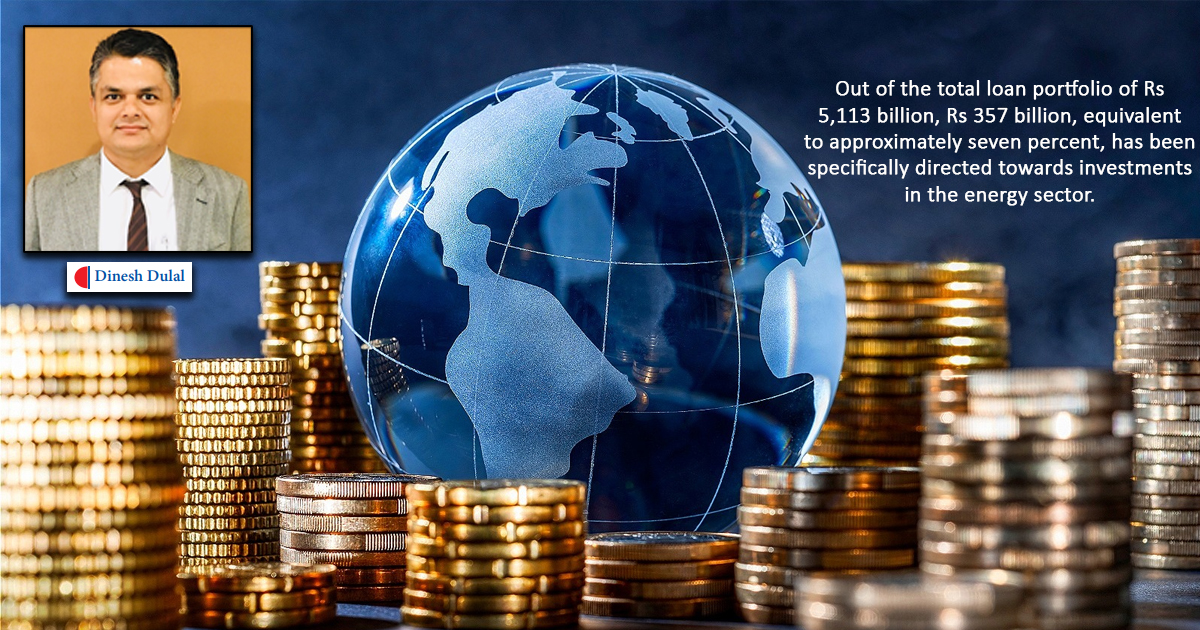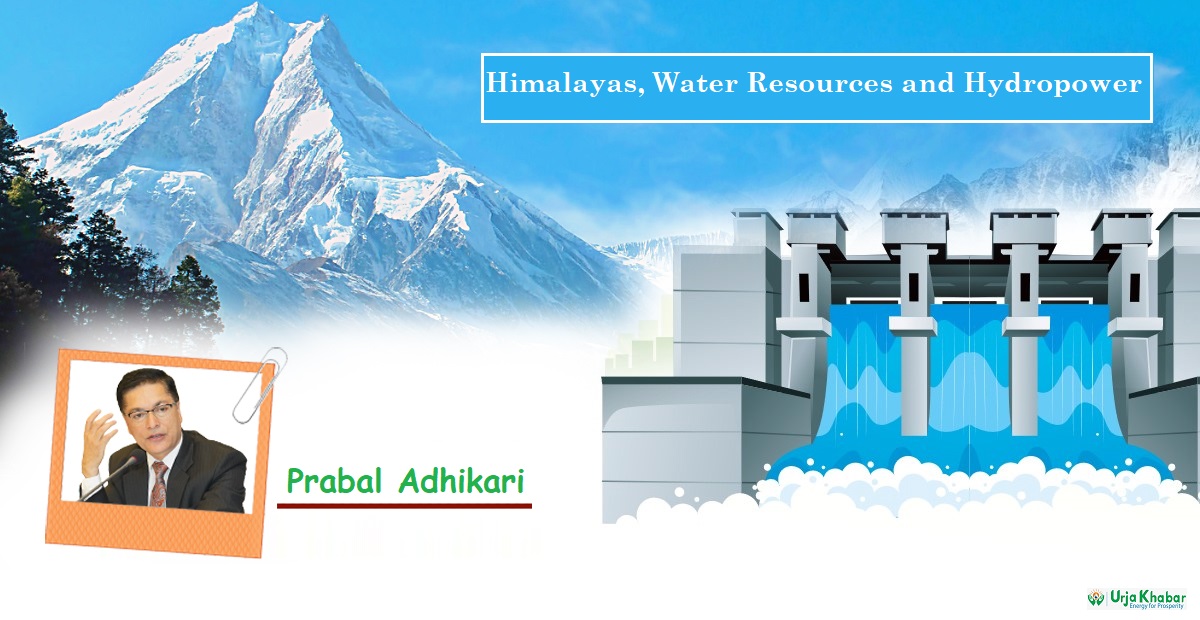Energy Update
Accelerating Momentum in Energy Sector Investment

The Nepalese energy sector is pivotal in driving the country’s economic development. Endowed with abundant renewable energy resources, Nepal has the potential to significantly enhance its energy security and address trade imbalances through the strategic development of its energy sector. Renewable resources offer sustainable alternatives to fossil fuels and present opportunities for expanding clean energy generation. By harnessing its renewable energy potential, Nepal can strengthen its energy security by providing essential energy resources that power industry, transportation, households, and various sectors crucial to economic activity. Diversifying energy sources reduces dependency on imported fuels, enhances resilience against supply disruptions, and stabilizes domestic energy prices.
Developing the energy sector, mainly through renewable energy exports, can help Nepal manage trade imbalances. Revenue generated from energy exports can contribute positively to the country’s economic growth and stability. Recent initiatives and policies promoting renewable energy and enhancing energy infrastructure underscore Nepal’s commitment to sustainable development. These efforts include expansions of hydropower projects, investments in solar energy, and improvements in energy efficiency. Ongoing developments in the sector reflect a proactive approach towards sustainable energy practices and economic resilience in Nepal.

In essence, investing in the energy sector, particularly in renewable resources, not only promotes sustainable development but also catalyzes broader economic benefits. It supports job creation, technology innovation, and infrastructure development while mitigating environmental impacts by laying a robust foundation for long-term economic prosperity and energy independence.
The recent developments witnessed in Nepal’s energy sector appear promising and significant. Here is a breakdown of the key points:

1. Nepal-Bangladesh Electricity Ties
The approval by the Government of Bangladesh to import 40 MW of hydropower from Nepal by using Indian transmission network, it marks a significant milestone. The next step is to finalize a trilateral agreement involving Nepal, India, and Bangladesh.
This bilateral and trilateral agreement can strengthen energy ties between the two countries, potentially leading to further collaborations in the future. Through this breakthrough, the energy tradewill now expand to the second South Asian energy-hungry country that can consume bigger capacity in the future. However, the dependency is still with neighboring country India because Nepal has to use the transmission infrastructure of India to export its power to Bangladesh. The initiative will be a stepping-stone for the long-discussed concept of a regional energy grid in South Asia. A connected grid can facilitate smoother energy trade, optimize resource utilization, and enhance grid stability across neighboring countries. The regional energy integration in South Asia will foster broader cooperation and lay the groundwork for future energy security and economic growth. This aligns with regional cooperation goals and can pave the way for broader economic ties.
2. Shift in Peak Energy Demand and Transition towards Green Economy:
Record-high temperatures are becoming increasingly common globally, reflecting a broader trend of climate change. These rising temperatures have significant impacts on weather patterns, ecosystems, and human societies. The global challenge of soaring temperatures is affecting countries worldwide, including Nepal. Summer months are becoming hotter, leading to increased heat stress on infrastructure, ecosystems, and human health. The rising temperatures contribute to an increased demand for cooling, known as the cooling load. In Kathmandu Valley and other areas, this translates into higher electricity consumption for air conditioning and cooling systems, placing additional strain on energy resources and infrastructure.
The Government of Nepal’s initiatives to promote electric transportation and electric cooking marks significant steps towards achieving a green economic transition. By incentivizing electric vehicles through policies such as import tax incentives, Nepal is encouraging a shift towards cleaner transportation options. EVs reduce reliance on fossil fuels, lowering greenhouse gas emissions and improving urban air quality. Promoting electric cooking appliances, such as electric stoves and induction cooktops, reduces reliance on traditional biomass or fossil fuel-based cooking methods. This transition not only improves indoor air quality and reduces health risks associated with traditional cooking fuels but also aligns with Nepal’s goals of reducing carbon emissions. Thanks to the scorching heat and the Government’s initiatives to transition towards electric transportation and cooking, Nepal’s peak energy demand crossed a record high of 2,300 MW. This shift of peak energy demand from the traditional festive day of Laxmi Puja to the hotter day of June indicates an increasing demand for reliable energy supply.
3. Exponential Investment
As of mid-May 2024, the total loans extended by banks and financial institutions in Nepal amounted to Rs 5,113 billion, marking an increase from Rs 4,880 billion recorded at the start of the fiscal year. This growth represents a 4.77 percent rise in loan volume over the period. Out of the total loan portfolio of Rs 5,113 billion, Rs 357 billion, equivalent to approximately seven percent, has been specifically directed towards investments in the
energy sector. This allocation underscores the significant role of financial institutions in supporting energy-related projects and initiatives in Nepal.
What stands out is the robust growth rate observed within the energy sector investments during this fiscal year. At 16.12 percent, the growth rate in investments within the energy sector is notably high compared to the overall industry’s loan growth rate of 4.77 percent. It indicates a focused effort and increased financial backing toward enhancing Nepal’s energy infrastructure, possibly driven by initiatives to expand renewable energy projects and meet growing energy demands sustainably.
This strategic allocation of loans towards the energy sector not only supports infrastructure development but also aligns with broader national goals of energy security, sustainability, and economic development. It reflects a proactive approach taken by Nepal Rastra Bank and the banks and financial institutions to channel resources into critical sectors that can drive long term socio-economic benefits for Nepal by setting directed lending targets in the energy sectors. The banking sector has to invest a minimum of 10 percent of its portfolio in the energy sector itself by the end of fiscal year 2026/27.
4. Reliable Electricity for Industrial Sector:
The unreliable electricity supply from the Nepal Electricity Authority (NEA) disrupts industrial operations significantly during the dry season. Industries rely heavily on consistent power supply to maintain production schedules, ensure product quality, and meet customer demands. When electricity is not dependable, it directly affects productivity and operational efficiency. The inability to rely on consistent electricity forces many industrial units to shut down operations intermittently. This not only leads to lost production time but also incurs financial losses. To mitigate these disruptions, some industries use fossil fuels like diesel generators, which are costly and environmentally detrimental. This undermines efforts towards sustainability and increases operational costs.
In today’s global economy, competitiveness hinges on efficient energy use. The industries that can access reliable and affordable electricity are better positioned to meet market demands and compete effectively. The unreliable energy supply puts Nepalese industries at a disadvantage compared to counterparts in countries with stable electricity grids. The challenges faced by NEA in providing reliable electricity stem from infrastructure limitations, maintenance issues, and sometimes inadequate policy support. Addressing these challenges requires substantial investment in upgrading infrastructure, implementing effective maintenance practices, and formulating policies that incentivize sustainable energy practices. To support industrial growth and competitiveness, Nepal needs to prioritize enhancing energy reliability. This involves improving grid infrastructure, investing in renewable energy sources such as hydropower and solar, and implementing smart grid technologies to manage energy distribution in a better way.
Government-industry collaboration is crucial to developing and implementing strategies that ensure a consistent and sustainable energy supply for industrial operations. Addressing the challenges of unreliable energy supply is essential for Nepal to foster industrial growth, enhance economic competitiveness, and achieve sustainable development goals. By investing in reliable energy infrastructure and promoting renewable energy solutions, Nepal can support its industries in becoming more resilient and competitive globally.
5. Ambitious Plan
The Government of Nepal has set an ambitious goal to achieve net-zero status by 2045, marking a pivotal shift towards sustainability. Central to this objective is developing 15,000 MW of energy infrastructure by 2030, a key priority area outlined in Nepal’s strategic planning.
Additionally, the Ministry of Energy’s Energy Roadmap details comprehensive plans to expand energy projects, aiming to develop approximately 28,500 MW of energy generation capacity by 2035. This roadmap can serve as a clear trajectory for Nepal’s energy sector, emphasizing substantial growth in energy production capabilities over the next eleven years. The ambitious expansion in energy infrastructure not only supports Nepal’s journey towards net-zero emissions but also creates significant investment opportunities within the energy sector itself. This increased demand for investment underscores the critical role of both domestic and international financial institutions in supporting Nepal’s energy sector development.
Overall, these strategic initiatives not only enhance energy security and sustainability but also contribute to economic growth and resilience, positioning Nepal as a leader in sustainable development within the region and globally.
6. Strong Rally in Secondary Market
Despite significant challenges, including weak regulatory oversight, financial losses, opaque financial practices, and corporate governance issues within hydropower companies, the hydropower sector has demonstrated a remarkable surge in its stock market index on the Nepal Stock Exchange in recent years.
This upward trend reflects a strong vote of confidence from public investors in the energy sector. It has enabled companies to raise capital through equity offerings in the capital market, which is essential for financing substantial energy infrastructure projects. Capital formation, facilitated by this investor confidence and market rally, plays a pivotal role in scaling up investment in larger and more impactful energy infrastructure in future. Moreover, the resilience of the hydropower sector in attracting investment amidst challenges highlights its strategic importance in Nepal’s energy landscape and its potential role in achieving broader economic and sustainable development goals. Despite facing multiple hurdles, the strong performance of the hydropower index in the Nepal Stock Exchange underscores the sector’s attractiveness to investors and its pivotal role in advancing Nepal’s energy security and infrastructure development.
7. Conclusion
Nepal’s energy sector plays a crucial role in driving economic growth and sustainability, mainly through its abundant renewable energy resources. The country’s strategic initiatives, including the Nepal-India and Nepal-Bangladesh Electricity Trade Agreement, highlight efforts towards regional energy integration and stability. These developments not only strengthen energy trade within South Asia but also pave the way for broader economic cooperation. The strong performance of the hydropower sector in capital markets reflects investor confidence and supports significant infrastructure investments crucial for economic development. Looking ahead, Nepal’s Energy Roadmap outlines ambitious plans to increase energy generation capacity, positioning the country as a leader in sustainable energy practices by 2035. Continued investment in infrastructure, technology, and policy frameworks will be essential to achieving these goals and ensuring a reliable energy supply for industrial and domestic consumers and cross-border electricity trade.
In summary, Nepal leads sustainable energy development in South Asia, with its energy sector poised to drive economic resilience and prosperity. Banks and financial institutions have played a pivotal role in supporting these initiatives, directing substantial investments toward the energy sector. This strategic allocation underscores the critical role of financial institutions in driving infrastructure development and economic growth. By leveraging renewable resources while promoting regional cooperation, Nepal has moved forward to establishing a robust foundation for long-term economic growth and energy independence. Continued investment in infrastructure, technology, and policy innovation, facilitated by financial institutions, will be pivotal in achieving these goals and securing a sustainable future for generations to come.
In Nepal, the energy sector’s expansion and modernization heavily rely on robust financial support from banks and financial institutions. These entities play crucial roles in providing the necessary capital to fund large-scale energy infrastructure projects. This shows that the financial sector’s commitment to supporting the energy sector’s growth and sustainability initiatives.
The financial support provided by banks facilitates the development of various energy projects, including hydropower, solar, and other renewable sources. These investments are essential for expanding Nepal’s energy generation capacity, enhancing energy security, and promoting sustainable development practices. By mobilizing necessary funds into energy infrastructure, financial institutions can contribute to job creation, technological advancements, and overall economic growth.
Moreover, the strategic allocation of funds toward energy projects demonstrates a proactive approach to addressing Nepal’s energy needs. It enables the country to reduce reliance on imported energy sources, stabilize domestic energy prices, and improve energy access across rural and urban areas. The financial sector’s involvement also fosters public-private partnerships and encourages international collaborations while leveraging expertise and resources for more efficient project implementation.
Finally, the role of bank financing in Nepal’s energy sector is pivotal for achieving long-term economic growth and energy independence. Continued investment in energy infrastructure, supported by banks and financial institutions, will be crucial in advancing Nepal’s sustainable development goals and ensuring a resilient energy future for upcoming generations.
(The writer of this article is the Chief of Sustainable Banking at NMB Bank Ltd. This article is taken from the 6th issue of Urja Khabar, a bi-annual magazine. Which was Published on 15 June, 2024)
Conversation
- Info. Dept. Reg. No. : 254/073/74
- Telephone : +977-1-5321303
- Email : [email protected]














.jpg)